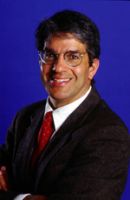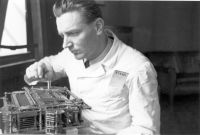
At first I assumed that everyone out there knows who I am, but perhaps I had better introduce myself. I am Paul Ceruzzi, Curator of Aerospace Computing and Electronics at the Smithsonian's
National Air and Space Museum, in Washington, D.C. My interests in the history of computing go back to my graduate school days at the University of Kansas, where in the mid-1970s I took what had to be one of the first courses on that topic offered anywhere. My doctoral dissertation, later published as a
book, arose in part from an opportunity, while on a Fulbright fellowship to the
Institute for the History of the Natural Sciences in Hamburg, to meet and interview
Konrad Zuse, one of the pioneers of computing from its "days of creation." I persuaded a fellow German student in the dormitory to help me compose a letter, in German, to him. Zuse not only replied, he invited me to his home in the village of Huenfeld, where I spent two days in intense conversations with him about computing and its origins. From then on I was hooked.

A question I often am asked is how I juggle my interest in general IT history with the specific topics of computing as they apply to aerospace. In an earlier day that was hardly a problem, as computing and aerospace were so closely linked (Even Zuse's
first computers were built to help design and manufacture German aircraft during the Second World War). Today the connections are less evident, and I am mindful of claims that "cyberspace" is to young people what "outer space" was to my generation, coming of age in the 1960s. This issue is also very much on the minds of exhibits planners at this museum, as we develop exhibits that we hope will attract young visitors, to whom the landings on the Moon are as far distant as the Great Depression was to me when the Apollo missions took place. I shall have more to say about that is a subsequent post.
So, with that as an introduction, let's begin.
 At first I assumed that everyone out there knows who I am, but perhaps I had better introduce myself. I am Paul Ceruzzi, Curator of Aerospace Computing and Electronics at the Smithsonian's National Air and Space Museum, in Washington, D.C. My interests in the history of computing go back to my graduate school days at the University of Kansas, where in the mid-1970s I took what had to be one of the first courses on that topic offered anywhere. My doctoral dissertation, later published as a book, arose in part from an opportunity, while on a Fulbright fellowship to the Institute for the History of the Natural Sciences in Hamburg, to meet and interview Konrad Zuse, one of the pioneers of computing from its "days of creation." I persuaded a fellow German student in the dormitory to help me compose a letter, in German, to him. Zuse not only replied, he invited me to his home in the village of Huenfeld, where I spent two days in intense conversations with him about computing and its origins. From then on I was hooked.
At first I assumed that everyone out there knows who I am, but perhaps I had better introduce myself. I am Paul Ceruzzi, Curator of Aerospace Computing and Electronics at the Smithsonian's National Air and Space Museum, in Washington, D.C. My interests in the history of computing go back to my graduate school days at the University of Kansas, where in the mid-1970s I took what had to be one of the first courses on that topic offered anywhere. My doctoral dissertation, later published as a book, arose in part from an opportunity, while on a Fulbright fellowship to the Institute for the History of the Natural Sciences in Hamburg, to meet and interview Konrad Zuse, one of the pioneers of computing from its "days of creation." I persuaded a fellow German student in the dormitory to help me compose a letter, in German, to him. Zuse not only replied, he invited me to his home in the village of Huenfeld, where I spent two days in intense conversations with him about computing and its origins. From then on I was hooked.
 A question I often am asked is how I juggle my interest in general IT history with the specific topics of computing as they apply to aerospace. In an earlier day that was hardly a problem, as computing and aerospace were so closely linked (Even Zuse's first computers were built to help design and manufacture German aircraft during the Second World War). Today the connections are less evident, and I am mindful of claims that "cyberspace" is to young people what "outer space" was to my generation, coming of age in the 1960s. This issue is also very much on the minds of exhibits planners at this museum, as we develop exhibits that we hope will attract young visitors, to whom the landings on the Moon are as far distant as the Great Depression was to me when the Apollo missions took place. I shall have more to say about that is a subsequent post.
So, with that as an introduction, let's begin.
A question I often am asked is how I juggle my interest in general IT history with the specific topics of computing as they apply to aerospace. In an earlier day that was hardly a problem, as computing and aerospace were so closely linked (Even Zuse's first computers were built to help design and manufacture German aircraft during the Second World War). Today the connections are less evident, and I am mindful of claims that "cyberspace" is to young people what "outer space" was to my generation, coming of age in the 1960s. This issue is also very much on the minds of exhibits planners at this museum, as we develop exhibits that we hope will attract young visitors, to whom the landings on the Moon are as far distant as the Great Depression was to me when the Apollo missions took place. I shall have more to say about that is a subsequent post.
So, with that as an introduction, let's begin.
